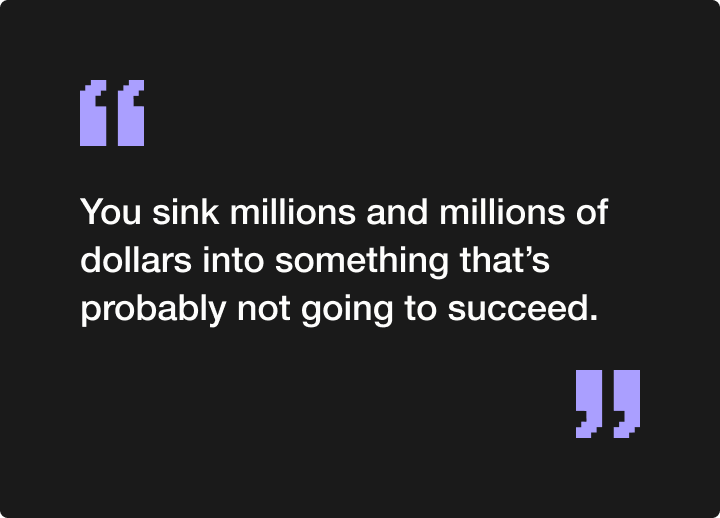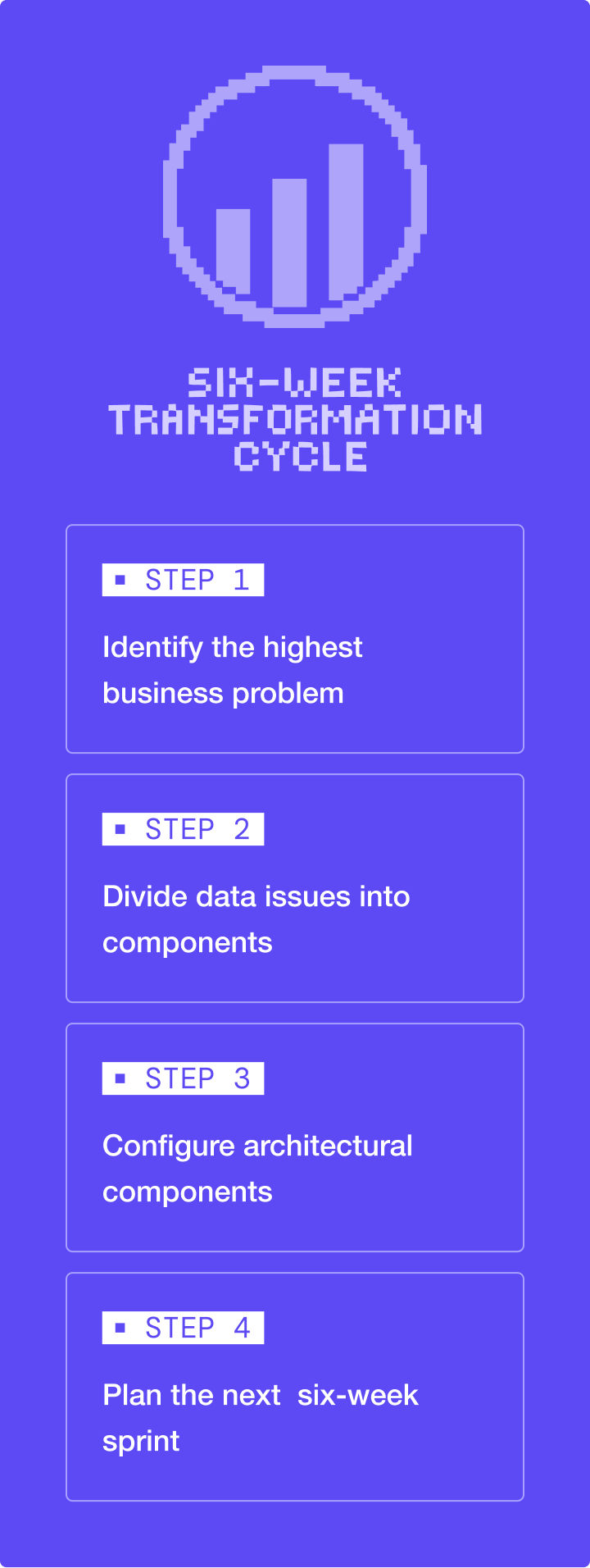The Limestone Protocol
How to Modernize Your Tech Stack in Six-Week Sprints
Today’s mid-market companies face a critical challenge: modernizing their tech stacks to become “AI-ready” while operating with limited resources.
This means fixing the data chaos that's bleeding money every day — broken pipelines, disconnected systems, and reports that take weeks instead of minutes.
For example, the average mid-market company runs into:


15-20% of revenue
Cost of data quality issues
7 - 12
Disconnected systems
3-6 month
Delays just to get basic
reporting
However, mid-market companies are forced to address these enterprise-level data complexities without the enterprise advantage of dedicated data teams. This makes it difficult to determine where to even begin with transformation, delaying implementation.
David Antoline is no stranger to this issue. He’s established a 25-year career in tech, working in both hands-on technical roles and strategic leadership across several industries.
He refers to this delay as “transformation paralysis” and notes that it can be costly. Companies stuck in this state risk failing to meet rising customer expectations while falling behind their more agile competitors.
Key takeaways:
- Mid-market companies experience “transformation paralysis” when modernizing their tech stack, delaying AI implementation and dulling their competitive edge.
- The Limestone Protocol breaks modernization into six-week sprints with specific goals, creating immediate value and building momentum through small, continuous wins.
- This incremental approach helps build organizational confidence in the process while reducing financial risk.


The “transformation paralysis” trap
Beyond the uncertainty surrounding how to initiate transformation, “transformation paralysis” stems from the fear of the issues that might arise once started.
Many organizations worry that they’ll uncover that they made incorrect assumptions about aspects like data quality or current customer usage patterns.
“Moving into a transformation project with an incomplete understanding of how customers use your current system is the fastest way to blow things up,” David says. This results in a misalignment between new systems and actual user workflows, preventing users from adopting those new systems in a meaningful way. Throughout his career, he’s seen companies reach this point, forcing them to start over halfway through multi-year projects.
Playing into the fear of uncovering deeper problems down the line is that failure at this stage is costly. A collapsed project potentially wastes several million investment dollars and substantial time spent away from the core business.
Together, the complexity of data problems and the fear of unanticipated issues lead implementation teams to delay transformation, which often creates friction between them and the organizational leaders who want to get started quickly and reap the rewards of modernization.
"This is ER-level stuff that's happening,” David highlights. “Organizations are terrified and feel like their competition is passing them by."
.png)

Gaining momentum through small wins
Many organizations adopt the mindset that they must address all of their data issues in one go and deliver value only at the end, leading them to dive into extended implementation periods with no visible progress.
After working through countless digital transformation projects, David has learned that combating paralysis requires a shift in perspective.
David is working on a more incremental, value-focused approach: the Limestone Protocol. This splits the broader transformation initiative into six-week sprints with specific goals.
The Limestone Protocol: Implementing the six-week sprint
By breaking transformation into smaller, more surmountable chunks requiring less financial commitment, organizations can start delivering measurable improvement quickly while reducing overall risk exposure.
David explains that these small wins create a powerful compounding effect. Each cycle builds upon the last, helping build organizational momentum and confidence in the transformation journey.
“You get maybe one or two percent better every six weeks," he says. "Then you start stacking that repeatedly. When you graph that against what we typically see — large spikes in excitement followed by giant crashes back to zero — you will be so far ahead of your competition."
We break down David’s six-week transformation cycle below.
.png)

Step 1: Identify the highest-impact business problem
Before organizations think about the data issues they need to tackle, they should determine the most important business problems facing their stakeholders.
Drawing from his experience at Limestone, David shares that 87% of companies misdiagnose their data problems, focusing on symptoms rather than root causes.
The method for uncovering the right problem involves:
- Interviewing key stakeholders
- Identifying the tasks they can’t perform
- Triaging their limitations based on the greatest business risk
David advises, “Change the word ‘data’ to the actual name of the type of stakeholder and the exact thing they can't do today. That's the project.”
For example, a company might uncover that its financial analysts can’t generate reconciliation reports without engineering support, preventing them from making informed decisions in a timely manner.
Step 2: Divide underlying data issues into components that can be addressed in six weeks
By identifying high-impact business problems, organizations can focus on the most pressing underlying data issues and begin to understand how exactly they need to be tackled.
However, organizations should divide the issue into components that can be addressed in just six weeks. For example, rather than overhauling all data pipelines at once, they could focus on the single pipeline that's blocking their most critical weekly report — an issue that can typically be fixed in three to four weeks.
This enables organizations to gain immediate return on investment in modernization, building buy-in for broader transformation efforts while ensuring they’re geared toward meeting true business needs.
Step 3: Configure flexible, replicable architectural components
Warning: 60% of companies build solutions that can't scale.
While organizations should be focused on meeting immediate needs in a six-week sprint, this shouldn’t come at the cost of future adaptability.
From data pipelines to API architecture, the architectural components they configure in a sprint should be flexible and designed to be replicated for other use cases.
David highlights that organizations don’t need to spend a significant amount of time deliberating about what might be required in the future, noting that 20% of their effort at the sprint stage will reveal the majority (80%) of future accommodations that need to be made.
For example, David and his team at Limestone Digital spent six weeks fixing a client’s inventory reporting. “By week three, we'd uncovered 80% of their data quality issues and integration needs,” he says. “Not through interviews and workshops, but by touching real data and seeing what broke.”
Step 4: Immediately plan the next six-week sprint to drive continuous improvement
Organizations should maintain a strict commitment to the six-week timeline, even if it means reducing the scope. This will help avoid delivery gaps that disrupt long-term momentum. Once complete, they should immediately begin planning the sprint, using insights from their most recent one to determine their priorities for the next.
Establishing this predictable rhythm of continuous improvement is critical, as it helps increase organizational trust in modernization at large. It also provides a valuable opportunity for leadership and implementation teams to better understand the relationship between different data points and broader business objectives.
Limestone’s 72% pilot-to-expansion rate reveals how David’s approach helps build lasting momentum.
“Drive continuous improvement,” David notes. “When you look back on a six-month period or a one-year period, you’ll just see win after win after win.”
.png)
.png)


Let's start with a diagnostic.
- Custom mapping of risks, integration points, and tech gaps
- Actionable follow-up playbook if there's a fit










